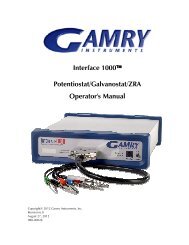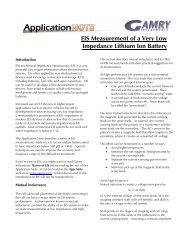Basics of Electrochemical Impedance Spectroscopy - Gamry ...
Basics of Electrochemical Impedance Spectroscopy - Gamry ...
Basics of Electrochemical Impedance Spectroscopy - Gamry ...
You also want an ePaper? Increase the reach of your titles
YUMPU automatically turns print PDFs into web optimized ePapers that Google loves.
Multiple Models<br />
The impedance spectrum in Figure 25 shows two clearly<br />
defined time constants.<br />
-ImZ<br />
0 RΩ<br />
Rp<br />
Figure 25. Two Time Constant Spectrum<br />
ReZ<br />
This spectrum can be modeled by any <strong>of</strong> the equivalent<br />
circuits shown in Figure 26.<br />
A<br />
B<br />
Figure 26. Equivalent Circuit Models with Two Time<br />
Constants<br />
As you can see, there is not a unique equivalent circuit<br />
that describes the spectrum. Therefore, you can not<br />
assume that an equivalent circuit that produces a good<br />
fit to a data set represents an accurate physical model <strong>of</strong><br />
the cell.<br />
Even physical models are suspect in this regard.<br />
Whenever possible, the physical model should be<br />
verified before it is used. One way to verify the model<br />
is to alter a single cell component (for example increase<br />
a paint layer thickness) and see if you get the expected<br />
changes in the impedance spectrum.<br />
C<br />
16<br />
Empirical models should be treated with even more<br />
caution. You can always get a good looking fit by<br />
adding additional circuit elements to a model.<br />
Unfortunately, these elements may have little relevance<br />
to the cell processes that you are trying to study.<br />
Empirical models should therefore use the fewest<br />
elements possible.<br />
Kramers-Kronig Analysis<br />
The Kramers-Kronig (K-K) relations can be used to<br />
evaluate data quality. The K-K relations demand that<br />
causal, complex plane spectral data shows dependence<br />
between magnitude and phase. The real part <strong>of</strong> a<br />
spectrum can be obtained by an integration <strong>of</strong> the<br />
imaginary part and vice versa.<br />
The K-K relations will always be true for EIS data that is<br />
linear, causal, and stable. If measured real and<br />
imaginary spectral data do not comply with the K-K<br />
relations, the data must violate one <strong>of</strong> these conditions.<br />
Unfortunately, the K-K transform requires integration<br />
over a range <strong>of</strong> frequency from zero to infinity. Since<br />
no one can measure spectral data over that range,<br />
evaluating the K-K relations via integration always<br />
involves assumptions about the behavior <strong>of</strong> a spectrum<br />
outside the frequency over which it was measured.<br />
In practice, K-K analysis is performed by fitting a<br />
generalized model to spectral data. Agarwal et al 1<br />
proposed use <strong>of</strong> a model consisting <strong>of</strong> m series<br />
connected Voigt elements: -R-(RC) m-. A Voigt element<br />
is a resistor and capacitor connected in parallel. The<br />
parameter m is generally equal to the number <strong>of</strong><br />
complex plane data points in the spectrum. This model<br />
is by definition K-K compliant. If you can obtain a good<br />
fit <strong>of</strong> this model to measured data, the data must also be<br />
K-K compliant. Boukamp 2 , proposed a means for doing<br />
the fit via linear equations, eliminating possible nonconvergence<br />
issues. This is the approach taken in<br />
<strong>Gamry</strong>’s K-K fit within the Echem Analyst.<br />
In the <strong>Gamry</strong> Echem Analyst, when you select Kramers-<br />
Kronig on an impedance menu a model <strong>of</strong> the type<br />
described above is fit to the selected region <strong>of</strong> the<br />
spectrum. If the fit is poor, you can assume that the<br />
data is not K-K transformable and is therefore <strong>of</strong> poor<br />
quality. There is little point fitting non-K-K compliant<br />
data to an equivalent circuit model.<br />
A tab in the Echem Analyst allows you to look at the<br />
goodness-<strong>of</strong>-fit and a plot <strong>of</strong> the residuals (difference<br />
between the fit and the data) versus frequency. A pre-




